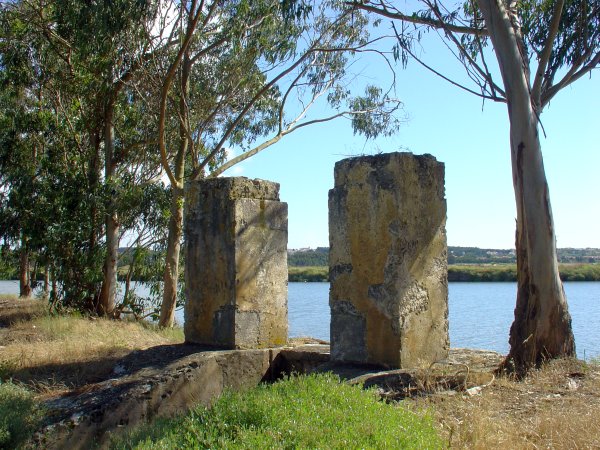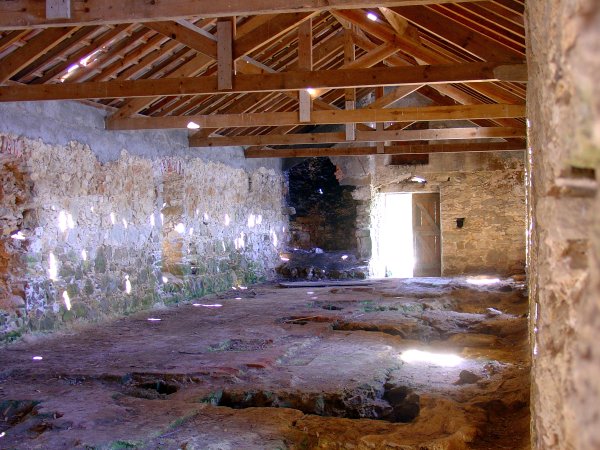
Originalmente património dos Jesuítas, a
Quinta do Canal foi confiscada à Companhia de Jesus e em 1769 foi
doada pelo Marquês de Pombal ao seu Secretário de Estado Adjunto,
José de Seabra e Silva (1732-1813). Depois de uma trajectória
política atribulada, José de Seabra e Silva é forçado em 1799 ao
exílio na Quinta do Canal e só 5 anos depois recebe autorização do
rei para de lá sair.
Entre os rios Pranto e Mondego, a maior parte da quinta é ocupada
pelo cultivo do arroz, no que resulta uma extensa e verde paisagem
natural, com vista privilegiada sobre a margem Norte do Mondego,
desde a ponte da Figueira da Foz à Serra de Castros.
Dos vários acessos possíveis à Quinta, o mais conveniente para
aceder à cache é pela ponte em N40º06.091' W8º48.406', seguida pela
entrada na quinta e a agora em ruínas casa do guarda.
Once belonging to the Jesuits,
the "Quinta do Canal" was confiscated from "Companhia de Jesus" and
donated by Marques de Pombal to his Secretary of State José de
Seabra e Silva (173-1813).
After a bumpy political
trajectory, José de Seabra e Silva is exiled in 1799 to "Quinta do
Canal" and only five years later authorized to go out.
Between the Mondego and Pranto
rivers, most of the farm is composed of rice crops, thus providing
a broad green natural landscape, with a privileged view over the
north bank of the Mondego, from the Figueira Bridge to "Serra de
Castros".
Among the possible access routes
to the farm, the most convenient one to reach the cache is the
bridge at N40º06.091' W8º48.406', followed by the farm entrance and
the now abandoned guard house.
Dentro da Quinta, basta seguir pela estrada em direcção a Oeste e
aproveitar a paisagem!
Once at the farm, simply follow
the road, head West and enjoy the view!
O troço final é feito por uma bela e estreita estrada de terra
batida com Eucaliptos à direita e o Rio Pranto à esquerda. Em
N40º06.778' W8º48.998' há um bom sítio para deixar o carro, a
cerca de 100 m do Moinho das Doze Pedras.
The final stretch is a lovely and
narrow dirt road with Eucalyptus trees on your right and the
Pranto River on your left. A good spot to park is at N40º06.778'
W8º48.998', at roughly 100 Yards from the "Moinho das Doze Pedras",
or Twelve Stones Mill.

Um moinho de marés funciona de
maneira muito simples: uma comporta permite aproveitar o subir da
maré para encher um reservatório, a caldeira. Quando a maré começa
a vazar, a comporta é fechada para manter o nível de água na
caldeira. Assim, passado algum tempo há um desnível entre os níveis
de água na caldeira e no rio.
A Tidal Mill works on a quite
simple principle: a gate is open during the rising tide to fill a
"pool". When the tide starts going down, the gate is closed in
order do keep the level at the pool, so that after some time the
water level at the pool and at the river are quite
different.

Por baixo do moinho existe um
conjunto de rodízios (uma espécie de roda com pás) que na maré
baixa ficam a descoberto e fazem girar a mó por força da água que
sai da caldeira para o rodízio e depois para o rio.
No moinho das Doze Pedras, apesar de uma tentativa de recuperação
no final da década de 80, infelizmente apenas se encontram buracos
abertos para o rio, que deixam adivinhar o trabalhar dos rodízios
por baixo e das mós por cima.
Under the mill there is a set of
paddled wheels that are above water level at low tide and are
forced to spin by the water flow from the pool to the river, thus
setting the grinding weels (or rocks in a literal translation) in
motion.
Despite of a recuperation attempt
by the end of the 80's, unfortunately only the floor holes to the
river give an hint on how the hole thing operated.
Estes buracos fazem do chão do moinho uma autêntica manta de
retalho e uma armadilha para um visitante mais desatento.
A cache não está no interior do
moinho, pelo que não é necessário correr riscos.
These holes in the floor turn the
mill house in a patchwork-trap for a careless visitor. The cache is not inside de mill house,
so there is no need to take chances.